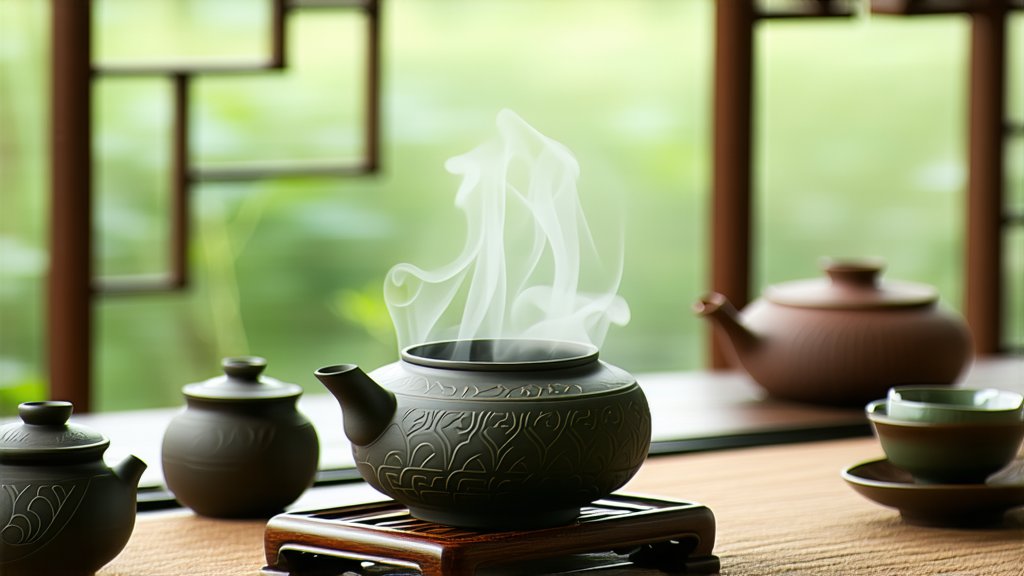
Pu-erh tea, a unique gem in the crown of Chinese tea culture, stands as an intriguing testament to the artistry and science behind tea production. This dark tea variety, originating from the Yunnan province, boasts a rich history intertwined with the ancient trade routes and cultural exchanges that have shaped its journey through centuries. In this exploration, we delve into the depths of Pu-erh tea's heritage, varieties, intricate manufacturing process, and sophisticated tasting techniques that elevate it beyond mere beverage status to a cultural and health elixir.
Historical Tapestry: The Origins and Evolution of Pu-erh Tea
The story of Pu-erh tea begins in the misty mountains of Yunnan, China, where legend has it that the tea was named after the market town of Pu-erh during the Qing Dynasty. Its roots trace back even further to the Tang Dynasty (618-907 AD), when tea bricks were first compressed for easier transportation along the ancient Silk Road. Over time, Pu-erh evolved not just as a commodity but as a symbol of sophistication and a medium for fostering diplomatic relations between China and neighboring regions.
Varietals and Characteristics: Unraveling the Diversity of Pu-erh
Pu-erh tea is broadly categorized into two types: raw (Sheng) and ripe (Shou). Raw Pu-erh, also known as traditional or green Pu-erh, undergoes minimal processing post-harvest, allowing it to age naturally over years, sometimes decades, developing complex flavors and aromas akin to fine wine. On the other hand, ripe Pu-erh undergoes a controlled fermentation process called 'wet piling' before compression, accelerating its aging process and imparting a mellower taste profile. Each type offers distinct sensory experiences, reflecting the terroir of their respective growing regions within Yunnan.
Crafting Excellence: The Art of Pu-erh Tea Production
The journey from leaf to cup in Pu-erh tea involves several meticulous steps. It starts with the careful selection of Camellia sinensis var. assamica leaves, known for their robustness and high polyphenol content. Post-harvest, these leaves undergo withering and rolling to initiate oxidation. For raw Pu-erh, this step is followed by sun drying and then pressing into various shapes like cakes, bricks, or tuocha (nestled shapes). Ripe Pu-erh diverges here, undergoing a pile fermentation process where damp leaves are stacked and turned regularly, fostering microbial activity that accelerates maturation. Both processes culminate in the formation of dense, earthy tea cakes that promise a lifetime of transformation.
A Symphony of Senses: Tasting and Appreciating Pu-erh Tea
Tasting Pu-erh tea is a ritualistic experience that engages all senses. Begin by warming the teapot and cups to enhance aroma perception. Use boiling water to rinse the leaves briefly, discarding this initial infusion to 'wake up' the tea. Subsequent steepings reveal layers of flavor—earthy undertones in raw Pu-erh give way to hints of woodiness, dried fruits, and a lingering sweetness; while ripe Pu-erh envelops the palate with smooth, mellow notes reminiscent of caramel and autumn leaves. Pay attention to the tea's body, astringency, and the evolving aftertaste, which can differ significantly between infusions.
Health Harmony: The Wellness Benefits of Pu-erh Tea
Beyond its cultural significance, Pu-erh tea is celebrated for its numerous health benefits. Rich in antioxidants, particularly catechins and theaflavins, it supports cardiovascular health by regulating cholesterol levels. Its probiotic properties aid digestion, while potential anti-inflammatory effects contribute to overall wellness. Moreover, regular consumption is believed to aid in weight management and promote longevity, making it a cherished addition to a balanced lifestyle.
In conclusion, Pu-erh tea encapsulates the essence of Chinese tea tradition, offering a window into the past while continuously evolving in the present. Its intricate production methods, diverse varieties, and profound health benefits make it a captivating subject of study and enjoyment for tea enthusiasts worldwide. As you embark on your own journey with Pu-erh tea, remember that each sip carries with it stories of centuries, inviting you to savor not just a drink but a piece of living history.